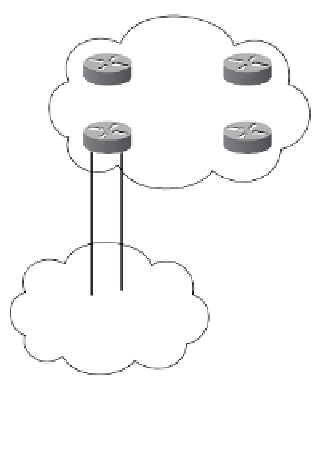Information Technology Reference
In-Depth Information
Stub Network Single-Homed
The stub network design, shown in Figure 6-1, is most commonly seen in small businesses.
This design often provides very little, if any, redundancy. When Internet connectivity is not
vital to business operations, this design option can provide a low-cost solution.
Figure 6-1
Enterprise Border Stub Router Architecture
Provider A (AS 100)
Enterprise (AS 65100)
A single-homed stub network does not require the use of BGP. The provider configures a
static route for the customer's prefix. The enterprise configures a static default route.
If multiple circuits are used between the provider router and customer router, multiple static
routes are used. The use of multiple connections in this design assumes that they are all
connected to the same routers. The level of redundancy provided is minimal and protects
only against circuit failure. Router failure results in full loss of connectivity.
Stub Network Multihomed
The stub network multihomed design option is often used by small- to medium-sized busi-
nesses. The enterprise is connected to a single upstream provider, but instead of connecting
to the provider at a single point, the enterprise connects to the provider in multiple places.
This provides an increased level of redundancy in that failure of a provider router is pro-
tected in addition to circuit failure.
It is common to use BGP in a stub environment when multihoming is employed. In the stub
environment, the enterprise typically receives a default route and, at most, partial prefixes.
There is very seldom a reason to receive full routing information in a stub environment.




















